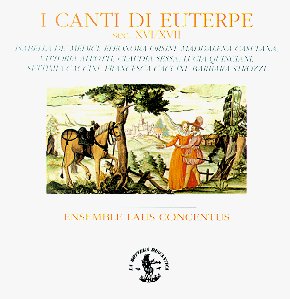Settimia Caccini facts for kids
Settimia Caccini (born October 6, 1591 – died around 1638 in Italy) was a famous Italian singer and composer. She lived in the 1600s and was one of the first women to have a very successful music career. People admired Settimia for her amazing artistic and technical skills in music. She came from a family of well-known musicians. Her father was Giulio Caccini, and her sister was Francesca Caccini. Settimia Caccini is not as famous for her compositions because she never published her own music collection. Instead, nine of her songs are found in two old handwritten books. Settimia was much more known for her singing talent. She performed for important noble families, both with her family's singing group and as a solo artist. Because she grew up in a musical family, she was able to become famous and successful on her own.
Contents
Settimia Caccini's Early Life
Settimia Caccini was born on October 6, 1591, in Florence, Italy. Her father, Giulio Caccini, was a very popular composer. He was a leader in a new style of music called monodic music, where one singer performs with simple instrument music. From a young age, her father taught her about music and how to compose. Her mother, Lucia Gagnolanti, was also a singer, but she passed away when Settimia was young.
Settimia was the youngest of three children. Her sister Francesca also became a very famous composer. Her older brother, Pompeo Caccini, was a singer too. Growing up in a home full of musicians helped her learn and master music at a young age. This later led to her fame and success. It was common for families back then to pass down their careers to their children.
Singing for the Medici Family
Settimia's father, Giulio, worked for the powerful Medici family. They ruled over much of Florence. Giulio made sure his family was involved in his music. He even created a family singing group. While working for the Medici, Giulio learned about the concerto delle donne. This was a group of professional female singers hired by the court of Ferrara.
It is thought that Giulio convinced the concerto delle donne to train his daughters to sing like them. Instead of singing alone, which was popular then, Giulio wanted them to train as a group. This group was called Il Concerto Caccini. Both Settimia and Francesca sang the soprano part, which is the highest voice. In 1600, the sisters sang in their father's opera, Il rapimento di Cefalo. This was for the wedding of Maria de' Medici and Henry IV of France.
Settimia's Solo Career and Marriage
Settimia and her sister grew up performing and learning music together at the Medici theater. Later, the family members went their separate ways to build their own music careers. Settimia became famous as a solo artist in 1608. She went to Mantua and sang the role of Venus in Monteverdi's opera L'Arianna.
During her successful career, Settimia received many marriage proposals and job offers. She turned down offers from the court of Mantua and from Enzo Bentivoglio in Rome. Instead, in 1609, Settimia married Alessandro Ghivazzani. He was a singer and composer from Lucca. In the same year, both Settimia and Alessandro started working for the Medici family. In 1611, they left the Medici court. In 1612, they moved to Mantua to work for the Gonzaga court. Ghivazzani worked in Mantua until his death around 1632.
After her husband's death, Settimia returned to Florence. She rejoined the Medici court in 1636. She stayed there until she passed away sometime between 1638 and 1640. The exact date of her death is not certain.
Settimia Caccini's Music Career
Settimia Caccini is mostly known for singing songs by other composers and starring in operas. She was a very famous singer and highly respected by people at the time. She also composed music, but none of her works were published by her or while she was alive. She wrote many pieces, but most of them are now lost. She started composing music when she was young. In 1611, she wrote her own piece for the Mascherate delle Ninfe della Senna carnival in Venice. For most of her career, she performed for kings, queens, and other important noble people. She sang for Henry IV, the king of France, with her sister when she was younger.
Performances for Noble Families
When she was older, Settimia and her husband worked for Duke Ferdinando Gonzaga at Mantua in 1613. The Gonzaga family was a powerful family in Mantua. Records show that Settimia was highly valued because she received a very good salary. Next, the couple worked in Parma for Cardinal Farnese in 1622. In 1628, Monteverdi asked Settimia to perform in Parma. Settimia sang as Dido in one of Monteverdi's intermedi (short musical plays) and as Aurora in "Mercurio e Marte." Monteverdi said Settimia sang the songs with "superhuman grace and angelic voice."
Surviving Compositions
Eight of Settimia Caccini's compositions have survived. All of them are Italian monodies with accompaniment. These pieces have very expressive melodies. They are usually performed by a single singer with a basso continuo (a simple bass line played by instruments). This style was perfect for her to sing. These were a very popular type of Italian monody. Some of her songs are now published as piano pieces, like in the book 4 Arias. Her most famous published piece was a short song called Gia sperai non spero hor piu. It was printed in a collection of old music from the 1600s.
Some of Settimia Caccini's other works for soprano voice and basso continuo include "Core di questo core," "Cantan gl'augelli," and "Due luce ridenti."
See also
 In Spanish: Settimia Caccini para niños
In Spanish: Settimia Caccini para niños


